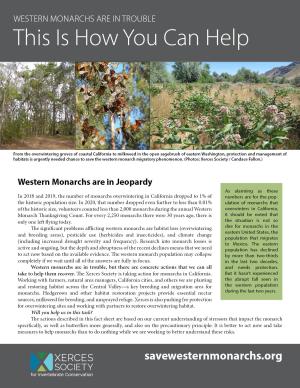
In 2018 and 2019, the number of monarchs overwintering in California dropped to 1% of the historic population size. In 2020, that number dropped even further to less than 0.01% of the historic size, volunteers counted less than 2,000 monarchs during the annual Western Monarch Thanksgiving Count. For every 2,250 monarchs there were 30 years ago, there is only one left flying today.
The significant problems afflicting western monarchs are habitat loss (overwintering and breeding areas), pesticide use (herbicides and insecticides), and climate change (including increased drought severity and frequency). Research into monarch losses is active and ongoing, but the depth and abruptness of the recent declines means that we need to act now based on the available evidence. The western monarch population may collapse completely if we wait until all of the answers are fully in focus.
Western monarchs are in trouble, but there are concrete actions that we can all take to help them recover. The Xerces Society is taking action for monarchs in California. Working with farmers, natural area managers, California cities, and others we are planting and restoring habitat across the Central Valley—a key breeding and migration area for monarchs. Hedgerows and other habitat restoration projects provide essential nectar sources, milkweed for breeding, and unsprayed refuge. Xerces is also pushing for protection for overwintering sites and working with partners to restore overwintering habitat.
Will you help us in this task?
In this document we offer simple steps that any individual can take to help support the western monarch population. This is intended as a companion document to the Western Monarch Call to Action, linked in the Related Resources list.
Originally released January 2019; updated January 2021.
